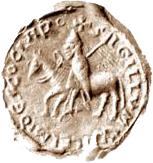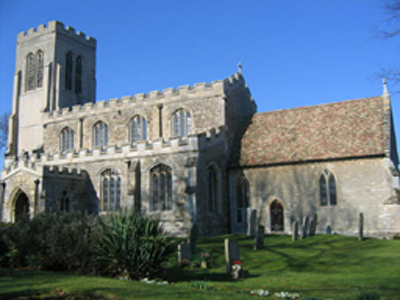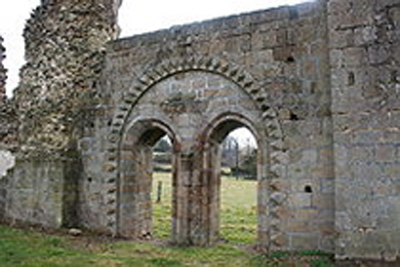William de Saint Clair
William de Saint Clair was possibly the eldest of the two Saint Clair brothers. He donated land in Normandy in 1135, confirmed later by his brother Hamo in 1139.
If Hamo was born c.1099, William might have been born a few year’s earlier, although other brothers and sisters might have been lost to the records. It has been suggested by a French genealogist that there was a sister called Basilie, but no evidence has been provided.
Like Hamo, William also benefited from Eudo dapifer’s escheated land. He was granted Hamerton in Huntingdonshire by Henry I, which amounted to 15 hides (1800 acres). He also held Greenstead, a manor of 4 hides (480 acres) outside the liberties of Colchester, and after Eudo’s death in 1120, William seized the tithes that he had granted to St. John’s Abbey in Colchester. Between 1141 and 1151 William restored these tithes to the abbey, with the consent of Hamo and his son, Hubert.
In 1130-31, he was holding Winfrod (Wynford Eagle) in Dorset, which was assessed at 14 hides (1680 acres). It was probably lost when he died because it was part of Gilbert de l’Aigle’s honour in 1199. In 1204-05 it was confiscated by the crown, and granted to Hubert de Burgh and his wife Margaret, confirmed by royal charter in 1231. During king Stephen’s struggle with the empress Matilda, William witnessed the first charter to Geoffrey de Mandeville in 1140, indicating that he, and probably Hamo, supported Stephen.
In 1135, with Hamo’s agreement, William donated land their ancestors held at Thaon in the diocese of Bayeux to the church of the Holy Trinity of Savigny near Mortain in the south of Normandy. In 1139, Hamo and Hubert confirmed the donation, adding Villiers, and in 1143 William wrote to the bishop of Bayeux and the empress Matilda emphasising his right to make the gift and asking them to protect it on behalf of the monks of Savigny. Much of the land at Villiers held by Richard de Villiers was gifted by William to Savigny, possibly after his death, even though he and Hamo had at least one half brother, Roger de Vilers.
Although it is not known who William married, it is believed he had one daughter called Matilda. Stephen granted Aubrey de Dammartin and Matilda the manor of Hamerton in 1152-53 to hold by the service of one knight, presumably after the death of her father. Hubert confirmed their gift of the church at Hamerton to St. John’s Abbey before he died in 1155, which suggests that it had passed to him, maybe on the death of Matilda. In 1156, William de Lanvalei had remission of 30s. of danegeld in respect of Hamerton and thereafter it descended in that family.
It is not clear when William died, but it would have been before 1152-53 when Aubrey and his daughter held Hamerton. There is the suggestion that he died in or soon after the Second Crusade in 1149, but no documentary evidence has been found. Later, in 1190, Richard de Saint Clair, a descendant of Richard de Saint Clair of Wortham and Lexham, is known to have gone on crusade.


